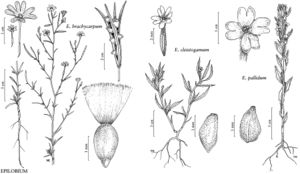Epilobium brachycarpum
Reliq. Haenk. 2: 30. 1831.
Herbs slender. Stems erect, terete, 15–200 cm, simple to paniculate-branched (especially in larger plants), glabrous proximally, strigillose distally, sometimes mixed glandular puberulent. Leaves subsessile or petiole 1–4 mm, blade linear to linear-lanceolate or narrowly elliptical, often folded along midrib, 1–5.5(–7) × 0.1–0.8 cm, usually shorter than internodes, base tapered or cuneate, margins remotely denticulate, 2–10 teeth per side, lateral veins obscure, 2–5 per side, apex acute or acuminate, surfaces subglabrous and sometimes glaucous to strigillose; bracts very reduced, sometimes attached to pedicel. Inflorescences erect, open panicles with filiform branches or simple racemes, glabrous or strigillose, often mixed glandular puberulent. Flowers usually erect; buds 1–12 × 1–3.5 mm; floral tube obconic to funnel-form, 1–16 × 0.8–2.9 mm, with ring of spreading hairs near mouth inside, in larger flowers, ring swollen; sepals green to reddish green, 1–8.5 × 0.8–2.1 mm, apex acute, abaxial surface strigillose and glandular puberulent to subglabrous; petals white to pink or deep rose-purple, 1.5–15(–20) × 1–7.5 mm, apical notch 0.5–6.5 mm; filaments usually cream-white, rarely pink, those of longer stamens 1–9.5 mm, those of shorter ones 0.5–6.3 mm; anthers cream, 0.5–4 × 0.3–2 mm; ovary 2–16 mm, strigillose, often mixed glandular puberulent, to subglabrous; style cream, 2–18 mm, stigma clavate to subcapitate, entire to deeply 4-lobed, 0.5–1.9 × 0.3–2.5 mm, surrounded by stamens or (in some larger flowers) exserted beyond anthers. Capsules erect or ascending, 15–32 mm, surfaces strigillose and glandular puberulent or glabrous; pedicel 1–17 mm. Seeds obovoid to broadly obovoid, with constriction 0.3–0.7 mm from micropylar end, 1.5–2.7 × 0.8–1.3 mm, chalazal collar inconspicuous, brown or gray, often flecked with darker spots, surface low papillose; coma easily detached, white to dingy white, 5–10 mm. 2n = 24.
Phenology: Flowering Jun–Sep.
Habitat: Open, dry or seasonally moist, often disturbed ground in open woods, meadows, prairies, roadsides and stream banks.
Elevation: 0–3000 m.
Distribution
Alta., B.C., Man., Ont., Que., Sask., Ariz., Calif., Colo., Idaho, Ky., Mont., Nev., N.Mex., N.Dak., Oreg., S.Dak., Utah, Wash., Wis., Wyo., introduced in South America (Argentina), Europe (Germany, Spain).
Discussion
The presence of Epilobium brachycarpum in Kentucky and Wisconsin is in railroad yards, so possibly ephemeral. This species occurs as an adventive in Argentina, possibly by natural long-distance dispersal (J. C. Solomon 1982), and in Spain (J. Izco 1983) and Germany (T. Gregor et al. 2013), probably from human introduction, since it frequently occurs as a weed on margins of cultivated fields (L. H. Shinners 1941).
Most populations of this self-compatible species have small autogamous flowers, but some populations with larger outcrossing flowers that exhibit marked protandry and herkogamy are pollinated by bees, butterflies, and occasionally hummingbirds.
Mature plants of Epilobium brachycarpum sometimes have only alternate or fasciculate leaves. However, seedlings always have opposite leaves in first pairs, but these are often deciduous.
Selected References
None.
